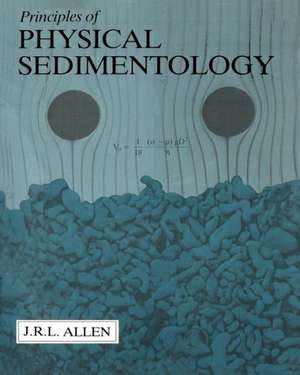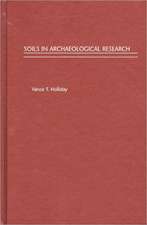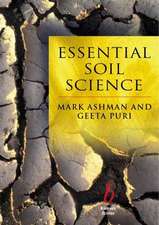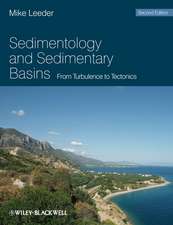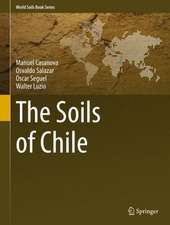Principles of Physical Sedimentology
Autor John Allenen Limba Engleză Paperback – 19 apr 2012
Preț: 702.73 lei
Preț vechi: 826.75 lei
-15% Nou
Puncte Express: 1054
Preț estimativ în valută:
134.46€ • 141.14$ • 111.61£
134.46€ • 141.14$ • 111.61£
Carte tipărită la comandă
Livrare economică 10-24 aprilie
Preluare comenzi: 021 569.72.76
Specificații
ISBN-13: 9789401096850
ISBN-10: 9401096856
Pagini: 292
Ilustrații: XVI, 272 p.
Dimensiuni: 203 x 254 x 15 mm
Greutate: 0.58 kg
Ediția:Softcover reprint of the original 1st ed. 1985
Editura: SPRINGER NETHERLANDS
Colecția Springer
Locul publicării:Dordrecht, Netherlands
ISBN-10: 9401096856
Pagini: 292
Ilustrații: XVI, 272 p.
Dimensiuni: 203 x 254 x 15 mm
Greutate: 0.58 kg
Ediția:Softcover reprint of the original 1st ed. 1985
Editura: SPRINGER NETHERLANDS
Colecția Springer
Locul publicării:Dordrecht, Netherlands
Public țintă
ResearchCuprins
1 Concepts and rules of the game.- 1.1 Matter and influences.- 1.2 Flow rate.- 1.3 Law of continuity (conservation of mass).- 1.4 Law of conservation of momentum.- 1.5 Law of conservation of energy.- 1.6 Energy losses during fluid flow.- 1.7 Newton’s laws of motion.- 1.8 Fluid viscosity.- 1.9 Boundary layers.- 1.10 Flow separation.- 1.11 Applying the concepts and rules.- Readings.- 2 Pressed down and running over.- 2.1 Introduction.- 2.2 Particle composition and density.- 2.3 How big is a particle?.- 2.4 What form has a particle?.- 2.5 How close is a packing?.- 2.6 Kinds of packing.- 2.7 Voids.- 2.8 Controls on packing.- 2.9 How steep is a heap?.- 2.10 Building houses on sand.- Readings.- 3 Sink or swim?.- 3.1 Two introductory experiments.- 3.2 Settling of spherical particles arrayed in a stagnant fluid.- 3.3 Settling and fluidization.- 3.4 Flow in porous media.- 3.5 Controls on permeability.- 3.6 Settling of a solitary spherical particle in a stagnant fluid.- 3.7 Settling of a solitary non-spherical particle in a stagnant fluid.- Readings.- 4 Sliding, rolling, leaping and making sand waves.- 4.1 Some field observations.- 4.2 Setting particles in motion.- 4.3 Defining the rate of sediment transport.- 4.4 Physical implications of sediment transport.- 4.5 Sediment transport modes.- 4.6 Appearance and internal structure of bedforms.- 4.7 How do bedforms move?.- 4.8 Bedforms and flow conditions.- 4.9 Making wavy beds.- 4.10 A wave theory of bedforms.- Readings.- 5 Winding down to the sea.- 5.1 Introduction.- 5.2 Drag force and mean velocity of a river.- 5.3 Energy and power of channelized currents.- 5.4 Why flow in a channel?.- 5.5 Width: depth ratio of river channels.- 5.6 Long profiles of rivers.- 5.7 An experimental interlude.- 5.8 Flow in channel bends.- 5.9 Sedimentparticles in channel bends.- 5.10 Migration of channel bends.- 5.11 A model for river point-bar deposits.- Readings.- 6 Order in chaos.- 6.1 Introduction.- 6.2 Assessing turbulent flows — how to see and what to measure.- 6.3 Character of an ideal eddy.- 6.4 Streaks in the viscous sublayer.- 6.5 Streak bursting.- 6.6 Large eddies (macroturbulence).- 6.7 Relation of small to large coherent structures.- Readings.- 7 A matter of turbidity.- 7.1 Introduction.- 7.2 A diffusion model for transport in suspension.- 7.3 Transport in suspension across river floodplains.- 7.4 Limitations of diffusion models.- 7.5 A dynamical theory of suspension.- 7.6 A criterion for suspension.- Readings.- 8 The banks of the Limpopo River.- 8.1 Introduction.- 8.2 Clay minerals.- 8.3 Deposition of muddy sediments.- 8.4 Packing of muddy sediments.- 8.5 Coming unstuck.- 8.6 Erosion of muddy sediments.- 8.7 Drying out.- Readings.- 9 Creeping, sliding and flowing.- 9.1 Introduction.- 9.2 Mass movements in general.- 9.3 Soil creep.- 9.4 Effective stress and losses of strength.- 9.5 Sub-aerial and sub-aquatic slides.- 9.6 Debris flows.- 9.7 Mass-movement associations.- Readings.- 10 Changes of state.- 10.1 Introduction.- 10.2 An experiment.- 10.3 What causes changes of states?.- 10.4 What forces cause deformation?.- 10.5 For how long can deformation proceed?.- 10.6 Complex deformations in cross-bedded sandstones.- 10.7 Load casts.- 10.8 Convolute lamination.- 10.9 Wrinkle marks.- 10.10 Overturned cross-bedding.- Readings.- 11 Twisting and turning.- 11.1 Introduction.- 11.2 Mixing layers.- 11.3 Jets.- 11.4 Corkscrew vortices.- 11.5 Horseshoe vortices due to bluff bodies.- 11.6 Horseshoe vortices at flute marks, current ripples and dunes.- Readings.- 12 Sudden, strong and deep.- 12.1 Some experiments.-12.2 Kinds of gravity current.- 12.3 Difficulties with gravity currents.- 12.4 Drag force and mean velocity of a uniform steady gravity current.- 12.5 Shape and speed of a gravity-current head.- 12.6 Why does the nose overhang?.- 12.7 Lobes, clefts and sole marks.- 12.8 Billows on the head.- 12.9 Gravity-current heads on slopes.- 12.10 Dissipation of sediment-driven gravity currents.- 12.11 Sloshing gravity currents.- 12.12 Turbidity-current deposits.- Readings.- 13 To and fro.- 13.1 Some introductory experiments.- 13.2 Making wind waves.- 13.3 Making the tide.- 13.4 Waves in shallow water.- 13.5 Waves in deep water.- 13.6 Wave equations.- 13.7 Mass transport in progressive and standing waves.- 13.8 Sediment transport due to wind waves and tides.- 13.9 Wave ripples and plane beds.- 13.10 Sand waves in tidal currents.- 13.11 Longshore bars and troughs.- 13.12 Waves and storm surges — back to the beginning.- Readings.
